Countycomm Gp-5 Ssb ( Gen 3 ) Review
 On Tuesday I received the new CountyComm GP5/SSB portable shortwave radio, a sample sent me from CountyComm. If y'all're familiar with the current shortwave portable landscape, then you'll quickly note that the GP5/SSB shares a striking resemblance to both the GP5/DSP and the Tecsun PL-360. While I hadn't anticipated writing yet some other radio article before the end of the year, having merely published a lengthy review of the CC Skywave, my marvel got the best of me…and before I knew information technology, I'd spent a few hours listening to and making notes near the CountyComm GP5/SSB as I put it through its paces. In the finish, I found I had the makings of a review.
On Tuesday I received the new CountyComm GP5/SSB portable shortwave radio, a sample sent me from CountyComm. If y'all're familiar with the current shortwave portable landscape, then you'll quickly note that the GP5/SSB shares a striking resemblance to both the GP5/DSP and the Tecsun PL-360. While I hadn't anticipated writing yet some other radio article before the end of the year, having merely published a lengthy review of the CC Skywave, my marvel got the best of me…and before I knew information technology, I'd spent a few hours listening to and making notes near the CountyComm GP5/SSB as I put it through its paces. In the finish, I found I had the makings of a review.
Who is CountyComm?
Different almost other brands I review, CountyComm has simply i or two shortwave radio offerings. I wanted to know a little of the back story and motivation behind creating the GP5/SSB, so I contacted CountyComm straight and spoke with their representative, Nick.
Nick explained that CountyComm is a retail benefactor of products created primarily for The states regime use. In a sense, CountyComm is the consumer spill-over from the thousands of products intended, for example, for state and federal agencies.
According to CountyComm, the GP5/SSB is a example in betoken. The company received a big social club from a United states authorities department for an "inexpensive, small portable, AM/FM/SW radio with SSB" for emergency supply caches and diplomatic posts. The GP5/DSP (a.k.a., Tecsun PL-360) fit the bill, simply lacked SSB. The asking was big enough that CountyComm approached SiLabs–manufacturer of the DSP bit in many of the portables on the market–and asked for help. SiLabs fabricated some design changes and worked directly with the mill in People's republic of china to produce the GP5/SSB.
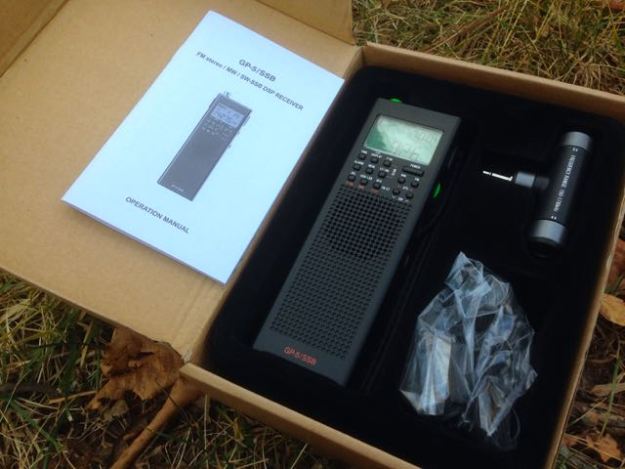
The GP5/SSB comes with a medium wave bar antenna, conduct pouch, stereo ear buds, wire antenna and manual.
Besides SSB, another interesting blueprint CountyComm implemented was extending the upper frequency range of the GP5/SSB to 29,999 kHz; previous and similar Tecsun models only had an upper limit of 21,950 kHz.
You may note that every bit of today, there are no like Tecsun portables on the market–this is because the first batch of units were designed for (and all purchased by) CountyComm. However, I have already heard rumblings that in that location volition soon exist a Tecsun PL-365 on the marketplace–if then, no dubiousness it volition turn out to be the GP5/SSB.
First impressions
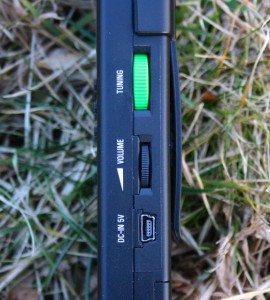 Appearance-wise, the GP5/SSB is near identical to its predecessor, the GP5/DSP or Tecsun PL-360. The vertical class factor is rather unique in the ultra-portable world, this radio is designed for i-handed operation, much like a handy-talky. The volume and tuning controls are on the right side of the radio and are designed to be operated by thumb (for right-handed operators, at any rate). All of the buttons on the forepart face are easily operated past your pollex–they're small, just have a firm response. The GP5/DSP (like its predecessor) lacks a dorsum stand, just does take a chugalug clip.
Appearance-wise, the GP5/SSB is near identical to its predecessor, the GP5/DSP or Tecsun PL-360. The vertical class factor is rather unique in the ultra-portable world, this radio is designed for i-handed operation, much like a handy-talky. The volume and tuning controls are on the right side of the radio and are designed to be operated by thumb (for right-handed operators, at any rate). All of the buttons on the forepart face are easily operated past your pollex–they're small, just have a firm response. The GP5/DSP (like its predecessor) lacks a dorsum stand, just does take a chugalug clip.
The small internal speaker produces clear audio, but sounds a picayune tinny; there is not even a hint of bass. Via headphones, the audio quality is far improve.
As well a slight modification to the keypad layout to accommodate the new addition of SSB and a bright dark-green antenna tip, the radio is identical to the GP5/DSP and Tecsun PL-360.
FM Performance
The CountyComm GP5/SSB, similar many other SiLabs-based receivers nosotros review, has first-class FM sensitivity.
Medium Wave (AM broadcast band) Functioning

The MW bar antenna increases performance–if using headphones, you will demand a right angle connector to allow the MW antenna to rotate 360 degrees
While I have not nevertheless had the opportunity to practise a proper comp recording session with the CountyComm GP5/SSB versus comparable radios, I plan to do so in the near future…stay tuned for that, right here! I'll create a post to give you a heads-upward when I've added medium wave samples to this review.
With that said, I expect the GP5/SSB functioning on medium moving ridge will be very similar to that of the GP5/DSP and Tecsun PL-360. I similar the included rotatable ferrite bar antenna that plugs into an external antenna port on top of the radio. It certainly helps with both overall sensitivity likewise every bit nullifying unwanted signals.
Shortwave performance
I've had a couple of opportunities to compare the GP5/SSB with other portables on the shortwave bands; embedded audio samples follow of a strong station, a weaker station, and even an SSB sample. Note that all of the sample recordings were taken during poor band conditions–QSB (fading) is pronounced.
Unmarried-sideband
Of course, when I received the GP5/SSB, the starting time thing I did was tune the ham radio bands in SSB mode.
Nick, the CountyComm rep in charge of the GP5/SSB pattern, is an amateur radio operator, and I'one thousand pleased that he represented the importance of a truly functional SSB way on this radio.
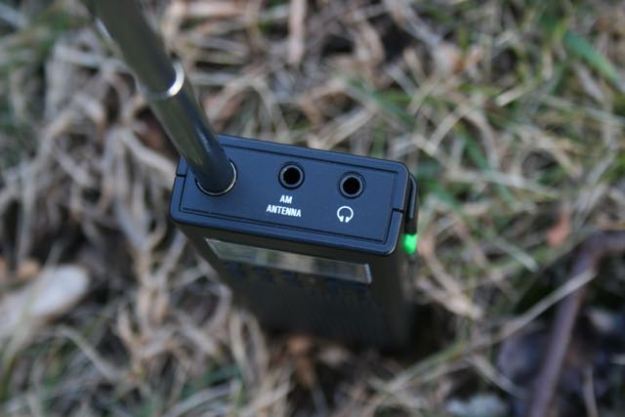 The GP5/DSP merely has 1 kHz tuning steps: more adequate for broadcast listening, but too coarse for SSB. Amateur radio operators do not necessarily transmit right on a frequency; they're ofttimes slightly off-frequency, either accidentally or intentionally. And older ham radios are as well prone to globe-trotting until the rigs take properly warmed up. Radios with SSB need finer-tuning controls to strop in on SSB signals. But the GP5/SSB has a piece of work-around for this.
The GP5/DSP merely has 1 kHz tuning steps: more adequate for broadcast listening, but too coarse for SSB. Amateur radio operators do not necessarily transmit right on a frequency; they're ofttimes slightly off-frequency, either accidentally or intentionally. And older ham radios are as well prone to globe-trotting until the rigs take properly warmed up. Radios with SSB need finer-tuning controls to strop in on SSB signals. But the GP5/SSB has a piece of work-around for this.
The GP5/SSB accommodates SSB by assuasive the listener to select either the upper or lower sideband, then use the BFO function to aid fine tune and cipher-shell a signal.
Specifically, here's how to melody to an SSB (phone) amateur radio indicate with the GP5/SSB:
- Turn on either the upper or lower sideband, depending on the meter band (generally, forty meters and beneath are lower; all else, upper).
- When yous hear a indicate, employ the 1 kHz tuning increments to find where it's strongest.
- Now, printing the BFO button once to activate BFO tuning; the U or L (indicating upper or lower) will brainstorm to glimmer.
- While the sideband indicator is blinking, utilise the tuning wheel to arrange the BFO. Adjust tuning until the voices in the signal audio natural.
Once you've done this a couple of times, the procedure becomes 2d nature.
Overall, I'm very pleased with the SSB functionality and performance. While I prefer either very fine tuning increments, or a separate BFO knob (no room for that on this tiny radio), I appreciate that CountyComm has used the BFO role to eliminate the demand for a separate tuning wheel.
Audio samples
While at that place are a number of portable radios with SSB on the marketplace, there are very few in this $lxxx toll range with SSB. Indeed, to my knowledge there are no other SSB-capable portables currently on the market that are every bit compact equally the CountyComm GP5/SSB.
I decided the best comparison radio would be one with a similar price, thus I used the Tecsun PL-600, which (at time of posting) is readily available from Amazon for the aforementioned $80 toll tag every bit the GP5/SSB.
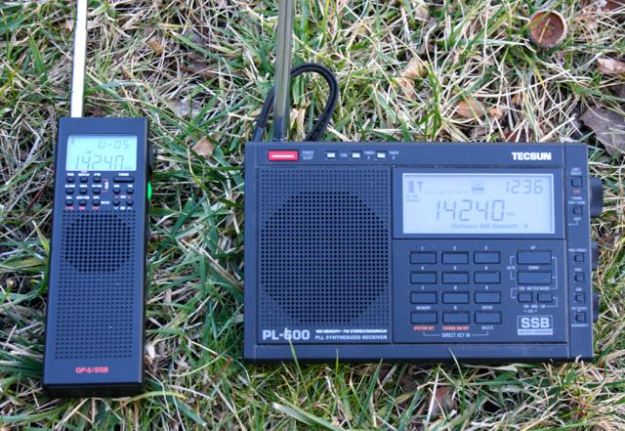
Beneath, you can hear two representative sound samples of how each radio receives an SSB conversation between two ham radio operators on the 20 meter band. I like this sample considering ane of the operators has a very strong signal, while the other is much weaker:
Tecsun PL-600 SSB sample
CountyComm GP5/SSB sample
You lot may notice that the GP5/SSB has a slightly college noise floor and DSP artifacts while listening to the weaker signal. The PL-600 sounds a picayune muffled in comparison.
I listened to many SSB signals that afternoon on the 20 and 40 meter ham radio bands. At length I concluded that I prefer the PL-600 for weak-signal listening. The PL-600's AGC could cope with the QSB better than the GP5/SSB.
With the bulk of the SSB signals, however, I constitute that the GP5/SSB's sound was clearer and voices seemed to "pop" out better than on the PL-600.

I should note that I too attempted to include the Grundig G6 in this comparison, merely the G6 somehow picked up dissonance from my digital recorder, thus making the recorded audio sound worse than it actually was. To my ear, the Grundig G6's SSB reception was very like to that of the CountyComm GP5/SSB–the G6 peradventure has a veryslight border in terms of weak-signal reception.
Shortwave broadcast listening (AM)
Wednesday afternoon, I had the adept fortune to tune in a relatively loud broadcast on 9620 kHz–turns out, it was Radio Nacional de España–! (This is a new shortwave relay service intended to supersede the Radio Exterior de España (REE) service that ended in October 2014).
I still had the PL-600 hooked upwardly to my digital recorder at that time; here's the comparison:
Tecsun PL-600 on 9620 kHz
CountyComm GP5/SSB on 9620 kHz
This morning I too had an opportunity to record Radio Australia on 12,065 kHz. This time, I had the Tecsun PL-310ET handy, so I used it for comparison:
Tecsun PL-310ET on 12,065 kHz
CountyComm GP5/SSB on 12,065 kHz
As you probably hear in these examples, the GP5/SSB has fine sensitivity, though not quite as skillful as the PL-310ET.
I've also noted good selectivity during casual circulate listening with the GP5/SSB.
Still, I practice not like the GP5/SSB's AGC (auto gain control) too as that of the other portables in this comparison–it's a petty too reactive to fading on the broadcast bands. To be fair, these audio samples really accentuated the AGC on the GP5/SSB since all were made during poor reception weather condition and pronounced fading.
Under normal atmospheric condition, I believe I would be quite pleased with the GP5/SSB; it's otherwise on par with about of the other ultra-portables on the market.
Summary
Every radio has pros and cons, and I jot downward my reactions as I evaluate a new radio so equally not to forget any details. The following is my listing:
Pros:
- Audio well-tailored for AM broadcast listening–fidelity quite expert via headphones
- Acceptable sensitivity and selectivity
- Clear, simple LCD dorsum-lit display
- SSB fashion is quite functional
- BFO feature allows for nil-trounce tuning
- Includes both upper and lower sideband selection
- Much like the PL-880, when in SSB fashion, the GP5/SSB will select ham bands when changing meter bands
- Extended frequency range (up to 29,999 kHz)
- Very good medium wave reception with supplied external bar antenna
- Uses 3 standard AA batteries
- Can be charged with common mini USB adapter
- Displays temperature in Fahrenheit (if MW set to 10kHz steps) or Celcius (if set up to 9 kHz steps)
- Great radio for an emergency kit or bug-out bag
- Designed for 1-hand operation/included chugalug prune (see con)
- United states Warranty
Cons:
- AGC doesn't cope with fading as well equally other comparable portables
- Audio from internal speaker rather tinny (without headphones)
- No back stand, nor rotatable whip antenna; thus this radio is non ideal for tabletop listening (run across pro)
- Supplied belt clip feels flimsy, if you plan to use this in the field, consider purchasing the fantabulous CountyComm GP5 series rugged case.
Who should purchase the GP5/SSB?
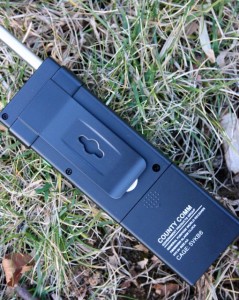 If you're looking for an ultra-portable radio for travel and general broadcast listening, I would encourage yous to consider the new C. Crane CC Skywave, the Tecsun PL-310ET or the Tecsun PL-380. Overall, the functioning and class factor of these radios are a better fit for broadcast listening. If yous're looking for armchair SSB listening, a larger portable with a larger internal speaker such as the Tecsun PL-600 is a practiced choice for the same cost as the GP5/SSB.
If you're looking for an ultra-portable radio for travel and general broadcast listening, I would encourage yous to consider the new C. Crane CC Skywave, the Tecsun PL-310ET or the Tecsun PL-380. Overall, the functioning and class factor of these radios are a better fit for broadcast listening. If yous're looking for armchair SSB listening, a larger portable with a larger internal speaker such as the Tecsun PL-600 is a practiced choice for the same cost as the GP5/SSB.
If you lot're looking for an ultra-portable radio with SSB, then the GP5/SSB is a very adept selection (if non the only ultra-portable SSB choice currently on the marketplace). While the SSB performance tin't compare with larger, pricier receivers and ham radio transceivers, it'southward very expert for $80 US.
If you lot're looking for an emergency communications receiver–something to stash in your vehicle, emergency kit or issues-out purse–the CountyComm GP5/SSB is a swell choice and value. Indeed, that's who the GP5/SSB was designed for; that'due south why this rig has splendid frequency coverage in all modes, with good sensitivity/selectivity and designed for portable, i-hand operation. In fact, CountyComm has even designed and manufactured (in the United states!) a robust, protective 1000-Denier case for the GP5/SSB. This case makes information technology very like shooting fish in a barrel to strap the GP5/SSB to your belt or backpack securely.
 In conclusion, the CountyComm GP5/SSB was designed for a specific purpose: to be an emergency communications receiver. It does this job quite well, despite any shortcomings in comparison to other popular shortwave portables, and for this purpose, I can recommend it.
In conclusion, the CountyComm GP5/SSB was designed for a specific purpose: to be an emergency communications receiver. It does this job quite well, despite any shortcomings in comparison to other popular shortwave portables, and for this purpose, I can recommend it.
Purchase the CountyComm GP5/SSB from Universal Radio.
Source: https://swling.com/blog/2014/12/a-review-of-the-countycomm-gp5ssb-portable-radio-a-great-emergency-portable/
0 Response to "Countycomm Gp-5 Ssb ( Gen 3 ) Review"
Post a Comment